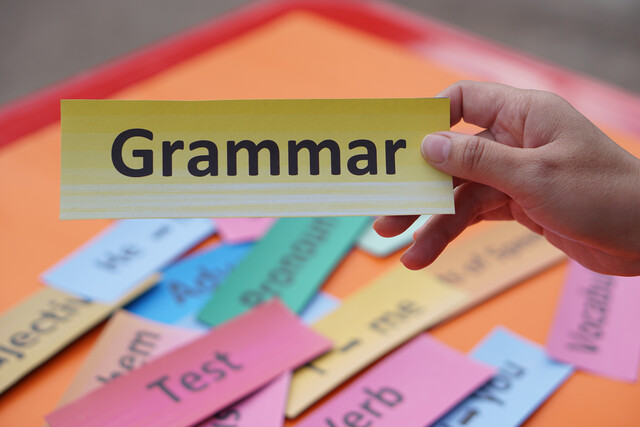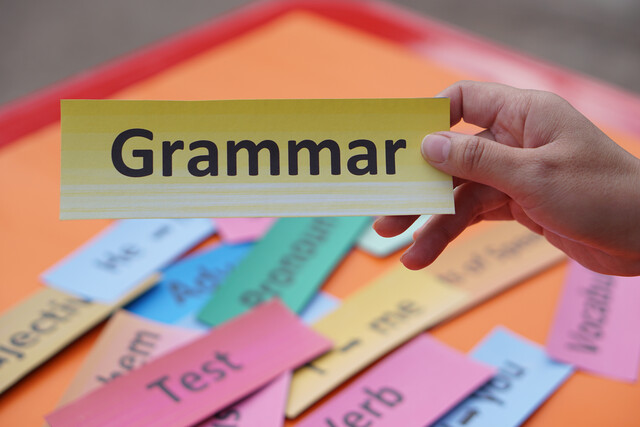Online Class: English Grammar Level 3

no certificate
with CEU Certificate*
-
12Lessons
-
27Exams &
Assignments -
568Students
have taken this course -
6Hours
average time -
0.6CEUs
Course Description
In today's fast-paced world, where written communication is paramount, the ability to write effectively is not just a skill, it's a necessity. Whether it's crafting a compelling narrative, presenting a convincing argument, or simply communicating ideas clearly, the power of writing cannot be underestimated. The English Grammar Level 3 course offers a unique opportunity to delve into the nuances of advanced grammar and writing mechanics, presenting a comprehensive platform for students to hone their writing skills.
This course is not just about learning rules; it's about understanding the mechanics of the English language and using them to create impactful, effective writing. It's designed for those who have a foundational understanding of English grammar and are ready to elevate their writing to a higher level.
In-Depth Course Narrative:
In the first lesson, "Mastering the Art of Writing," students embark on a journey into the world of creative and expressive writing. This isn't just about learning grammar rules; it's about understanding how to use these rules as tools to craft engaging narratives, compelling arguments, and clear, purposeful communication. Through a variety of techniques and exercises, students will learn how to enhance their writing style and bring their words to life.
As we move to "Crafting Effective Sentences," the focus shifts to the building blocks of writing. Here, students will explore the art of sentence construction, learning how to use varied sentence structures, effective incorporation of phrases, and the strategic use of conjunctions. The goal is to add depth and flow to their writing, transforming simple statements into powerful messages.
Building upon this foundation, the course then delves into "Building Strong Paragraphs." This lesson is about understanding how to group sentences into coherent and cohesive paragraphs. Whether it's for essays, reports, or stories, the ability to organize ideas logically and clearly is crucial. Students will learn key elements of paragraph structure and how to apply them effectively.
"Exploring Paragraph Varieties" further expands on this concept. Here, students will discover the different types of paragraphs -- expository, descriptive, narrative -- and learn how each can be used effectively to convey messages in a clear and compelling manner. This lesson is about understanding the purpose behind each paragraph type and mastering the ability to use them appropriately.
The course then takes an imaginative turn with "The Power of Showcasing vs. Telling." This lesson uncovers the secrets of 'show, don't tell' in writing. It's about learning techniques to show actions and emotions, creating a vivid picture in the reader's mind, rather than just telling them what is happening. This approach brings writing to life, making it more engaging and memorable.
In "Perspectives in Writing," the narrative shifts to the importance of point of view in writing. From first person to third person and omniscient, each perspective shapes the narrative and influences the reader's engagement with the story. Understanding these perspectives and how to use them effectively is key to powerful storytelling.
"Crafting Realistic Dialogue" explores the nuances of dialogue in writing. Students learn how to write convincing and engaging dialogue, using it as a tool to develop characters, advance the plot, and add depth to their stories. This lesson is about making conversations in writing feel real and impactful.
As students progress, "Mastering Interior Monologue" delves into the complexities of characters' thoughts and emotions. This lesson teaches how to effectively use interior monologue, a technique that adds a deeper layer to storytelling, revealing the inner workings of characters.
"The Art of Proportion in Writing" teaches students how to balance detail and pacing in their writing. This is about focusing on important events and maintaining narrative momentum, without overwhelming the reader with unnecessary details. It's a crucial skill for keeping readers engaged and ensuring that the writing is effective and purposeful.
In "Achieving Writing Sophistication," the course shifts focus to elevating the overall style of writing. This lesson provides strategies for students to enhance their writing, making it comparable to professional standards. It's about adding a level of sophistication to their work, ensuring it stands out.
"Avoiding and Replacing Poor Phrasing" addresses a common pitfall in writing. This lesson helps students identify weak phrases and replace them with stronger, more effective expressions. It focuses on refining writing for greater clarity and impact, ensuring that every word counts.
Finally, "The Essentials of Proofreading" emphasizes the importance of refining and polishing writing. Students learn techniques to catch errors and refine their drafts, ensuring their final manuscript is polished and error-free. It's about understanding that good writing is not just about what you say, but also how you say it.
Why Enroll?
English Grammar Level 3 is more than just a course; it's an opportunity to master the English language and use it as a powerful tool in both academic and professional settings. This course is ideal for students, professionals, and anyone who wishes to enhance their writing skills. Enroll now and start your journey to becoming a more effective and sophisticated writer.
- Completely Online
- Self-Paced
- 6 Months to Complete
- 24/7 Availability
- Start Anytime
- PC & Mac Compatible
- Android & iOS Friendly
- Accredited CEUs

Course Lessons
Lesson 1. Writing & Grammar: A Journey to Clarity
Advanced Grammar Level 3 is designed to refine your writing by deepening your understanding of grammatical structures and their strategic application. Through detailed lessons and practice exercises, you'll learn to avoid common pitfalls and enhance the clarity and impact of your writing.Lesson 2. Crafting Clarity: Sentence Construction Tips
Effective writing hinges on the craftsmanship of sentences, where clarity and engagement are paramount. Skillful sentence variety ensures that paragraphs maintain a natural flow, keeping readers interested and informed.Lesson 3. Understanding and Crafting Strong Paragraphs
Paragraphs serve as structural units in writing, grouping sentences around a central idea using topic sentences and supporting details. Mastering the coherence of paragraphs, aided by examples, enhances the clarity and appeal of the written narrative.Lesson 4. Paragraph Types Unveiled
To excel in paragraph writing, practice analyzing and crafting various types including narrative, descriptive, and expository, drawing inspiration from diverse examples in literature and informational texts. Each type demands a specific technique, offering a pathway to improved writing proficiency.Lesson 5. Visual Storytelling: Bringing Narratives to Life
Effective storytelling employs 'show, don't tell' to elevate reader engagement, turning abstract actions and feelings into tangible scenes. This technique breathes life into characters and settings, weaving a tapestry that draws readers into its world.Lesson 6. POV: The Lens of Storytelling
First person POV offers an intimate narrative experience by immersing the reader into the protagonist's personal thoughts and emotions, though it may limit narrative scope to the character's knowledge. Meanwhile, third person and omniscient POVs allow for broader narrative flexibility, offering insights beyond the protagonist's direct experience but perhaps at the expense of immediacy.Lesson 7. Mastering Dialogue: From Basic to Advanced Techniques
Dialogue serves as a narrative powerhouse, transforming character interactions into opportunities for deep thematic exploration and development. By leveraging nuances like subtext and double entendres, writers can convey complex emotions and themes through what remains unspoken, enhancing the reader's experience.Lesson 8. Insights into Characters' Minds
Interior monologue, a potent tool in fiction, offers readers direct access to characters' psyche, increasing empathy and narrative engagement. By distinguishing between direct and indirect styles, authors can effectively illuminate characters' internal conflicts and motivations.Lesson 9. Balancing Acts: Mastering Proportion in Writing
By allocating emphasis based on importance, writers use proportion to maintain reader engagement and ensure a cohesive narrative flow. This technique requires keen judgment and a deep understanding of storytelling dynamics.Lesson 10. Beyond Basics: Achieving Sophistication in Writing
Mastering sophisticated writing involves varied syntax, avoiding clichés, and crafting fresh metaphors to maintain reader interest and convey unique ideas. It also entails achieving a balance between dialogue and description, ensuring each word and sentence enhances the narrative's impact and meaning.Lesson 11. Refining Your Prose: The Path to Clearer and More Powerful Writing
Effective writing in any genre—academic, creative, or technical—requires clarity and precision, ensuring simple phrasing over convoluted expressions enhances understanding. While complexity can serve sophisticated ideas well, it is crucial that it only be as complex as necessary for the subject and audience.Lesson 12. Beyond the First Draft: Elevating Writing through Revisions
Even meticulous writers make mistakes, making the process of revising first drafts essential to great writing. Proofreading goes beyond spell check to include grammar, flow, and structure, ensuring accuracy and clarity.
Learning Outcomes
- Demonstrate the ability to construct clear and coherent sentences by applying advanced grammatical rules and structures.
- Identify and correct common grammatical errors in writing to ensure clarity and precision.
- Demonstrate the ability to combine simple sentences into complex or compound sentences for improved flow and interest
- Identify and apply techniques for varying sentence structures to enhance writing clarity and engagement
- Demonstrate the ability to use transitional phrases and consistent point of view in paragraphs to ensure logical sentence progression and coherence.
- Identify the components of a well-structured paragraph, including topic sentences, supporting details, and concluding sentences, to improve clarity in writing.
- Analyze and construct argumentative, analytical, and persuasive paragraphs to effectively convey a viewpoint or dissect complex information.
- Demonstrate the ability to identify and compose narrative, descriptive, and expository paragraphs by utilizing their specific characteristics and techniques.
- Demonstrate the use of dialogue and internal monologue to reveal character traits and emotions without explicit descriptions, enhancing character depth and narrative immersion
- Identify and employ sensory details and dynamic descriptions to transform basic narrative summaries into vivid scenes that enhance reader engagement
- Define the characteristics and differences between first person, third person, and omniscient points of view in writing and provide examples for each
- Demonstrate how the choice of point of view impacts narrative tension and thematic exploration in a story by analyzing different examples of each point of view
- Identify the purpose of dialogue in fiction by describing its role in character development, plot advancement, and world-building, with 90% accuracy.
- Demonstrate mastery of lesson content at levels of 70% or higher.
Additional Course Information

- Document Your Lifelong Learning Achievements
- Earn an Official Certificate Documenting Course Hours and CEUs
- Verify Your Certificate with a Unique Serial Number Online
- View and Share Your Certificate Online or Download/Print as PDF
- Display Your Certificate on Your Resume and Promote Your Achievements Using Social Media

Choose Your Subscription Plan
No Certificate / No CEUs
This course only
| Includes certificate | X |
| Includes CEUs | X |
| Self-paced |

|
| Instructor support |

|
| Time to complete | 6 months |
| No. of courses | 1 course |
Certificate & CEUs
This course only
| Includes certificate |

|
| Includes CEUs |

|
| Self-paced |

|
| Instructor support |

|
| Time to complete | 6 months |
| No. of courses | 1 course |
Certificates & CEUs
Includes all 600+ courses
| Includes certificate |

|
| Includes CEUs |

|
| Self-paced |

|
| Instructor support |

|
| Time to complete | 12 Months |
| No. of courses | 600+ |
Certificates & CEUs
Includes all 600+ courses
| Includes certificate |

|
| Includes CEUs |

|
| Self-paced |

|
| Instructor support |

|
| Time to complete | 24 Months |
| No. of courses | 600+ |
Related Courses
-
 2 hours
0.2 CEUs
Purchasing and Vendor Management 101
+ More Info
2 hours
0.2 CEUs
Purchasing and Vendor Management 101
+ More Info
-
 5 hours
0.5 CEUs
Emotional Intelligence
+ More Info
5 hours
0.5 CEUs
Emotional Intelligence
+ More Info
-
 16 hours
1.6 CEUs
Introduction to Music Appreciation
+ More Info
16 hours
1.6 CEUs
Introduction to Music Appreciation
+ More Info
-
 3 hours
0.3 CEUs
Criminology: The Anatomy of American Justice
+ More Info
3 hours
0.3 CEUs
Criminology: The Anatomy of American Justice
+ More Info
-
 6 hours
0.6 CEUs
Retirement Tips
+ More Info
6 hours
0.6 CEUs
Retirement Tips
+ More Info
-
 5 hours
0.5 CEUs
Personal Communication Skills Level 1
+ More Info
5 hours
0.5 CEUs
Personal Communication Skills Level 1
+ More Info
-
 5 hours
0.5 CEUs
Habits of Millionaires
+ More Info
5 hours
0.5 CEUs
Habits of Millionaires
+ More Info
-
 6 hours
0.6 CEUs
Personal Assistant 101
+ More Info
6 hours
0.6 CEUs
Personal Assistant 101
+ More Info
-
 5 hours
0.5 CEUs
Business Professionalism
+ More Info
5 hours
0.5 CEUs
Business Professionalism
+ More Info
-
 3 hours
0.3 CEUs
Cat Care and Training 101
+ More Info
3 hours
0.3 CEUs
Cat Care and Training 101
+ More Info
-
 5 hours
0.5 CEUs
Constructive Feedback and Criticism
+ More Info
5 hours
0.5 CEUs
Constructive Feedback and Criticism
+ More Info
-
 7 hours
0.7 CEUs
Wildlife Rehabilitation: An Introduction
+ More Info
7 hours
0.7 CEUs
Wildlife Rehabilitation: An Introduction
+ More Info
-
 18 hours
1.8 CEUs
Medical Terminology 101
+ More Info
18 hours
1.8 CEUs
Medical Terminology 101
+ More Info
-
 9 hours
0.9 CEUs
ESL Grammar Skills Level 4
+ More Info
9 hours
0.9 CEUs
ESL Grammar Skills Level 4
+ More Info






